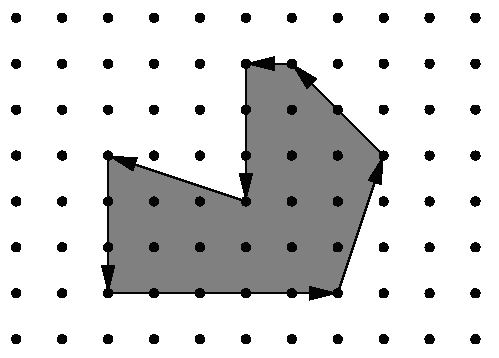标签:des style blog http color os io strong
链接:http://poj.org/problem?id=1265
| Time Limit: 1000MS | Memory Limit: 10000K | |
| Total Submissions: 4969 | Accepted: 2231 |
Description

Input
Output
Sample Input
2 4 1 0 0 1 -1 0 0 -1 7 5 0 1 3 -2 2 -1 0 0 -3 -3 1 0 -3
Sample Output
Scenario #1: 0 4 1.0 Scenario #2: 12 16 19.0
Source
-=-=-=-=-=-=-=-=-=-=-=-=-=-=-=-=-=-=-=-=-=-=-=-=-=-=-=-=-=
超时代码:

1 #include <stdio.h> 2 #include <math.h> 3 #include <string.h> 4 #include <stdlib.h> 5 #include <iostream> 6 #include <algorithm> 7 8 #define eps 1e-8 9 #define MAXX 210 10 using namespace std; 11 12 typedef struct point 13 { 14 double x; 15 double y; 16 }point; 17 typedef struct line 18 { 19 point st; 20 point ed; 21 }line; 22 23 bool dy(double x,double y) 24 { 25 return x>y+eps; 26 } 27 bool xy(double x,double y) 28 { 29 return x<y-eps; 30 } 31 bool dyd(double x,double y) 32 { 33 return x>y-eps; 34 } 35 bool xyd(double x,double y) 36 { 37 return x<y+eps; 38 } 39 bool dd(double x,double y) 40 { 41 return fabs(x-y)<eps; 42 } 43 44 double crossProduct(point a,point b,point c)//ac -> ab 45 { 46 return (c.x-a.x)*(b.y-a.y)-(c.y-a.y)*(b.x-a.x); 47 } 48 double dist(point a,point b) 49 { 50 return sqrt((a.x-b.x)*(a.x-b.x)+(a.y-b.y)*(a.y-b.y)); 51 } 52 53 bool onSegment_1(point a,point b,point c) 54 { 55 double maxx=max(a.x,b.x); 56 double minx=min(a.x,b.x); 57 double maxy=max(a.y,b.y); 58 double miny=min(a.y,b.y); 59 60 if(dd(crossProduct(a,b,c),0.0) && xyd(c.x,maxx) && dyd(c.x,minx) 61 && xyd(c.y,maxy) && dyd(c.y,miny)) 62 return true; 63 return false; 64 } 65 66 bool segIntersect_1(point p1,point p2,point p3,point p4) 67 { 68 double d1=crossProduct(p3,p4,p1); 69 double d2=crossProduct(p3,p4,p2); 70 double d3=crossProduct(p1,p2,p3); 71 double d4=crossProduct(p1,p2,p4); 72 73 if(xy(d1*d2,0.0) && xy(d3*d4,0.0)) 74 return true; 75 if(dd(d1,0.0) && onSegment_1(p3,p4,p1)) 76 return true; 77 if(dd(d2,0.0) && onSegment_1(p3,p4,p2)) 78 return true; 79 if(dd(d3,0.0) && onSegment_1(p1,p2,p3)) 80 return true; 81 if(dd(d4,0.0) && onSegment_1(p1,p2,p4)) 82 return true; 83 return false; 84 } 85 86 point p[MAXX]; 87 line li[MAXX]; 88 int n; 89 90 bool inPolygon_1(point pot) 91 { 92 int count=0; 93 line l; 94 l.st=pot; 95 l.ed.x=1e10; 96 l.ed.y=pot.y; 97 p[n]=p[0]; 98 for(int i=0; i<n; i++) 99 { 100 if( onSegment_1(p[i],p[i+1],pot )) 101 return true; 102 if(!dd(p[i].y,p[i+1].y)) 103 { 104 int tmp=-1; 105 if(onSegment_1(l.st,l.ed,p[i])) 106 tmp=i; 107 else if(onSegment_1(l.st,l.ed,p[i+1])) 108 tmp=i+1; 109 if(tmp != -1 && dd(p[tmp].y,max(p[i].y,p[i+1].y))) 110 count++; 111 else if(tmp == -1 && segIntersect_1(p[i],p[i+1],l.st,l.ed)) 112 count++; 113 } 114 } 115 if(count % 2 ==1) 116 return true; 117 return false; 118 } 119 120 bool inPolygon_2(point pot) 121 { 122 int count=0; 123 line l; 124 l.st=pot; 125 l.ed.x=1e10; 126 l.ed.y=pot.y; 127 p[n]=p[0]; 128 for(int i=0; i<n; i++) 129 { 130 if( onSegment_1(p[i],p[i+1],pot )) 131 return false; 132 if(!dd(p[i].y,p[i+1].y)) 133 { 134 int tmp=-1; 135 if(onSegment_1(l.st,l.ed,p[i])) 136 tmp=i; 137 else if(onSegment_1(l.st,l.ed,p[i+1])) 138 tmp=i+1; 139 if(tmp != -1 && dd(p[tmp].y,max(p[i].y,p[i+1].y))) 140 count++; 141 else if(tmp == -1 && segIntersect_1(p[i],p[i+1],l.st,l.ed)) 142 count++; 143 } 144 } 145 if(count % 2 ==1) 146 return true; 147 return false; 148 } 149 150 double Area(int n) 151 { 152 if(n<3)return 0; 153 int i; 154 double ret=0.0; 155 for(i=2; i<=n; i++) 156 { 157 ret+=(crossProduct(p[0],p[i-1],p[i])); 158 } 159 return fabs(ret)/2.0; 160 } 161 162 int main() 163 { 164 int m,i,j; 165 int ttmp=1; 166 scanf("%d",&m); 167 while(m--) 168 { 169 scanf("%d",&n); 170 p[0].x=0;p[0].y=0; 171 double x,y; 172 double maxx=-100,maxy=-100,minx=100,miny=100; 173 for(i=1; i<=n; i++) 174 { 175 scanf("%lf%lf",&x,&y); 176 p[i].x=p[i-1].x+x; 177 p[i].y=p[i-1].y+y;//printf("%lf %lf^^",p[i].x,p[i].y); 178 } 179 for(i=0; i<=n; i++) 180 { 181 maxx=maxx>p[i].x?maxx:p[i].x; 182 maxy=maxy>p[i].y?maxy:p[i].y; 183 minx=minx<p[i].x?minx:p[i].x; 184 miny=miny<p[i].y?miny:p[i].y; 185 }//printf("%lf %lf^^%lf %lf**",minx,maxx,miny,maxy); 186 int in=0,edge=0,sum=0; 187 point cas; 188 for(i=minx; i<=maxx; i++) 189 { 190 for(j=miny; j<=maxy; j++) 191 { 192 cas.x=i;cas.y=j; 193 if(inPolygon_1(cas)) 194 { 195 sum++; 196 } 197 if(inPolygon_2(cas)) 198 { 199 in++; 200 } 201 } 202 } 203 double area=Area(n); 204 edge=sum-in; 205 printf("Scenario #%d:\n",ttmp++); 206 printf("%d %d %.1lf\n",in,edge,area); 207 } 208 return 0; 209 }
poj 1265 Area (Pick定理+求面积),布布扣,bubuko.com
标签:des style blog http color os io strong
原文地址:http://www.cnblogs.com/ccccnzb/p/3928331.html